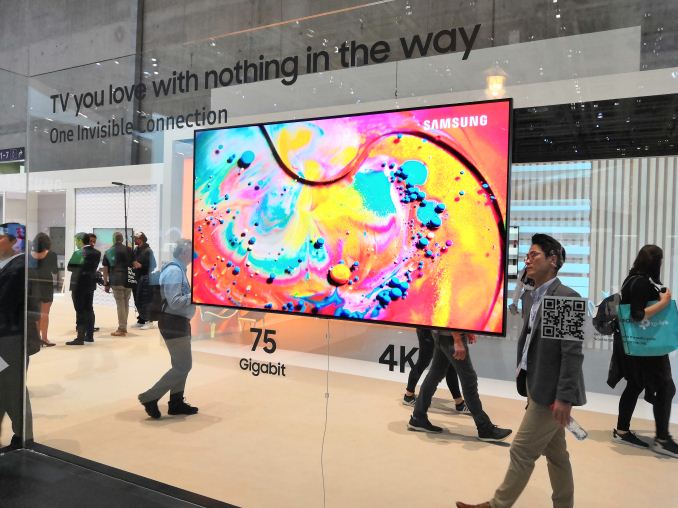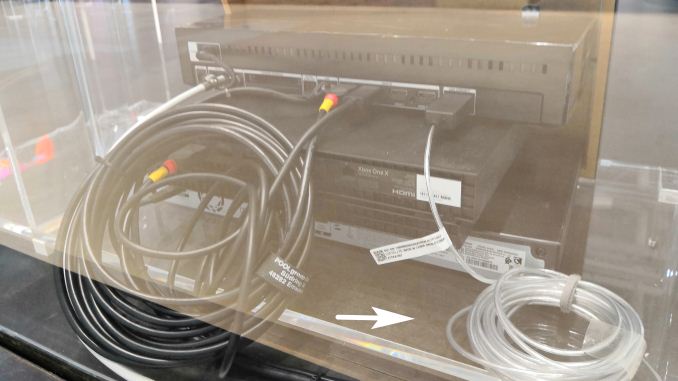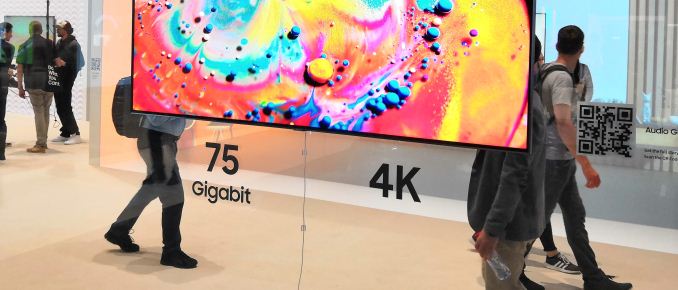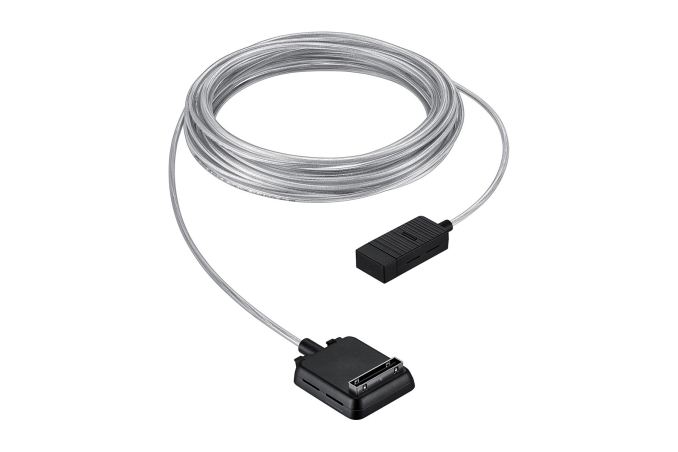Samsung’s One Invisible Connection: 75 Gbps and 230W in a Ultra Thin Cable
by Ian Cutress on September 13, 2018 2:00 PM EST- Posted in
- TV
- Samsung
- Trade Shows
- IFA 2018
- QLED

This perhaps isn’t news, but there was something super amazing that I saw on the show floor at IFA this year that I wanted to write about. Despite writing about the technology industry for nearly ten years, I still like to pace around a show floor to find new and exciting things. After bypassing room upon room of ovens and carbon-fibre fridges, I was stunned to be introduced to Samsung’s One Invisible Connection. This is a tiny thin cable that seems to do everything.
Everyone dislikes cables. If we could transmit data wirelessly, and transmit power wirelessly, I’m sure I speak for most people and say that our lives would be far less cluttered if we could do away with cable messes. Samsung’s One Invisible Connection, in turn, aims to simplify everything. In one small cable they are able to power a full-sized 4K display (up to 230W) as well as transmit 4K video (75 Gbps). A picture says a thousand words:
A cable supporting that much data and that much power, to me, seems crazy. Apparently Samsung is shipping this on all their high-end QLED displays already, and it connects to a host box which deals with power and the video inputs, such as a Blu-Ray player, console, or cable TV. (ed: for anyone wondering, the cable appears to be an optical cable with additional wires for carrying high voltage DC power)


Cable indicated by white arrow
I still can’t get over how thin this cable is. It’s as thin as my 65W charger cable for my laptop. And Samsung offers the cable in both 5m and 15m lengths (~16.5ft and ~50ft), so it's not a short-run cable either. I asked why it wasn’t a standard across everything, and the reason is because of the high cost. Not the cost of the cable, mind you, but rather the extra hardware that goes into the device before the TV, and into the TV itself. I tried to take a picture of the back of the TV, but it didn’t come out well. This is the danger of having a Perspex booth to demonstrate the technology.
Well like I said, it isn’t new. But it is something that made me a bit speechless.












30 Comments
View All Comments
megadirk - Thursday, September 13, 2018 - link
Wonder what the cost of the cable is to replace. Also the the box sitting directly on top of the xbox's exhaust is giving me anxiety.zeusk - Thursday, September 13, 2018 - link
xbox one x has the exhaust on rear.Gunbuster - Friday, September 14, 2018 - link
That factory anti fingerprint cling wrap they left on is the thing giving me anxiety. How could they not peel that? Don't send a non OCD slob to setup your display systems!!!stux - Monday, September 17, 2018 - link
I’ve seen prices up to 300$ for the 15M. This AU website says $199https://www.samsung.com/au/tv-accessories/opticalc...
SSTANIC - Thursday, September 13, 2018 - link
Hi Ian, Samsung has QLED (quantum dot enhanced LED), not OLED. A mystery for me are the HDMI and other standards, chips and cables that still can't carry e.g. 4K@144Hz or 5K@144 or 8K@60 etc. I've had a 5K monitor for, what, could be 4 years now? I would truly appreciate an in-depth AnandTech piece about that, I have to say. Keep up the great work, thumbs upGreenReaper - Friday, September 14, 2018 - link
Surely Wikipedia can handle that?https://en.wikipedia.org/wiki/HDMI#Version_compari...
(resolution specifications lower down)
https://en.wikipedia.org/wiki/DisplayPort#Resoluti...
(non-resolution spects in table above this one for DP)
B3an - Thursday, September 13, 2018 - link
Old news, and they've had a similar thing in previous years. BTW Samsung doesn't use "OLED displays" for their TVs. It's LCD still with "QLED" for the stupid marketing shit.chaos215bar2 - Thursday, September 13, 2018 - link
This. Seriously. Either just call them what they actually are, LCD, or use the proper marketing name. AnandTech of all places should get this right.chaos215bar2 - Thursday, September 13, 2018 - link
(Corrected. Thanks!)PeachNCream - Thursday, September 13, 2018 - link
That's a good idea. Sure HDMI setups only require two cables so the only thing you're really doing is eliminating a power cable, but it's a move in the right direction. No thanks on pushing 250W of electrical energy over open air as a logical next step. It just seems like there might be adverse health implications for sending that much power without a wire conductor. You'd need something like a microwave beam like we use for radio relay stations! I, for one, would not like to slowly cook my peachy self in that manner.